Papers by Neville Calleja

BMC Public Health, 2021
Background Disability-adjusted life years (DALYs) combine the impact of morbidity and mortality, ... more Background Disability-adjusted life years (DALYs) combine the impact of morbidity and mortality, allowing for comprehensive comparisons of the population. The aim was to estimate the DALYs due to Covid-19 in Malta (March 2020–21) and investigate its impact in relation to other causes of disease at a population level. Methods Mortality and weekly hospital admission data were used to calculate DALYs, based on the European Burden of Disease Network consensus Covid-19 model. Covid-19 infection duration of 14 days was considered. Sensitivity analyses for different morbidity scenarios, including post-acute consequences were presented. Results An estimated 70,421 people were infected (with and without symptoms) by Covid-19 in Malta (March 2020–1), out of which 1636 required hospitalisation and 331 deaths, contributing to 5478 DALYs. These DALYs positioned Covid-19 as the fourth leading cause of disease in Malta. Mortality contributed to 95% of DALYs, while post-acute consequences contribut...
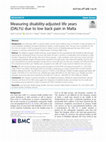
Archives of Public Health, 2020
Background Low back pain (LBP) is a public health concern and a leading cause of ill health. A hi... more Background Low back pain (LBP) is a public health concern and a leading cause of ill health. A high prevalence of musculoskeletal complaints has been reported for Malta, a small European state. The aim was to estimate for the first time the burden of LBP at population level in Malta in terms of disability-adjusted life years (DALYs) and compare to estimates obtained by the Global Burden of Disease (GBD) study. Method The Maltese European Health Interview Survey dataset for 2015 provided the LBP prevalence data through representative self-reported history of chronic LBP within the past 12 months in combination with limitations to daily activities. Proportions of LBP severity (with and without leg pain – mild, moderate, severe and most severe) and their corresponding disability weights followed values reported in the GBD study. Years lived with disability (YLD) for LBP were estimated for the whole population by age and sex. Since LBP does not carry any mortality, YLD reflected DALYs. ...
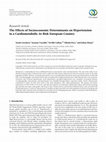
International Journal of Hypertension, 2017
Background. A relationship has been established between socioeconomic status and hypertension. Th... more Background. A relationship has been established between socioeconomic status and hypertension. The aim of this study was to determine the prevalence of hypertension and to explore the links between hypertension and socioeconomic factors in the adult population of Malta. Methods. A national representative cross-sectional health examination study was performed between 2014 and 2016. Sociodemographic and medical history data was gathered by validated questionnaires while blood pressure was measured. Prevalence rates of known hypertension, newly hypertension, and global hypertension were calculated. Associations between sociodemographic characteristics and hypertension were identified through logistic regression models. Results. Hypertension contributed to 30.12% (CI 95%: 28.71–31.57) of the study population, with a male preponderance. The majority was known hypertensive (73.59% CI 95%: 71.01–76.02), with only three-quarters on medication. Multivariant analyses showed that increasing ag...

Postgraduate Medical Journal, 2016
Objectives Although risk assessment is an integral part of management, there are currently no ris... more Objectives Although risk assessment is an integral part of management, there are currently no risk calculators of long-term mortality after acute coronary syndrome (ACS). The aim was to provide risk equations for 10-year and 20-year mortality following ACS. Methods Patients hospitalised with ACS from December 1990 to June 1994 were recruited and followed up through 31 December 2012. Results The study followed 881 patients for 10 years and 712 patients for 20 years. Using Cox regression analysis, 20-year all-cause mortality was associated with myocardial infarction (MI) in the index admission, age and diabetes mellitus (DM). Twenty-year cardiovascular disease (CVD) and cardiac mortality were both associated with MI in the index admission, age, DM and female gender. 10-year all-cause mortality was associated with age and total cholesterol levels; age, DM and total cholesterol levels were found to be independent predictors of 10-year CVD and cardiac mortality. Risk equations were conse...

Archives of Public Health, 2016
Background: Diabetes type 2 and obesity are well-established global epidemics and contributors to... more Background: Diabetes type 2 and obesity are well-established global epidemics and contributors to clinical, social and economic health burdens. The prevalence rates of these diseases are still on the rise among countries resulting in a corresponding public health burden. The Mediterranean island of Malta, known for it's high diabetes and obesity rates, provides a good fundamental basis to portray the economical health burden of these diseases. Method: A recent randomised stratified representative cross-sectional survey conducted in Malta tackling diabetes, obesity and other determinants, was used to work out the population prevalence of these diseases. The cost burden of diabetes and obesity, based on published data, was incorporated to the established population prevalence rates, in order to estimate the Maltese economical burden. Projections to the year 2050 by a bottom-up prevalence based design were performed. Results: One eight of the Maltese adults (25 to 64 years) suffered from diabetes out of which approximately 10,000 adults were unaware of the disease. Alarmingly, more than a third of the Maltese population suffer from obesity. The approximate health care costs (direct and indirect) for the diabetic adult population was of €29,159,217 (€21,994,676-€38,919,121) annually, amounting to 3.64% (2.75-4.875%) of the total health expenditure in Malta. The obesity cost burden was of €23,732,781 (€21,514,972-€26,049,204) annually contributing for 2.97% (2.69-3.26%) of the total health expenditure. The projected prevalence and costs for 2050 exhibited an estimated cost burden increase of €33,751,487 (€25,458,606-€45,048,473) for the diabetes mellitus population and €46,532,294 (€42,183,889-€51,074,049) for the obese population. These projected cost burdens are expected to increase exponentially the total health care expenditure in Malta by 2050. Conclusion: Having an understanding of the prevalence and the economic cost burden of diabetes and obesity within a country, along with projections of the expected burden will enable policy and public health officials to clearly visualize this growing problem. It also helps in establishing effective preventive strategies and screening programs targeting these epidemics.
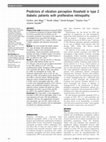
Postgraduate Medical Journal, 2011
Purpose of the study Distal peripheral neuropathy (DPN) is a troublesome complication of diabetes... more Purpose of the study Distal peripheral neuropathy (DPN) is a troublesome complication of diabetes mellitus (DM). The factors associated with the disease are still incompletely understood. The purpose of this study was to investigate factors associated with vibration perception threshold (VPT) as a marker of DPN in a type 2 diabetic population with advanced microvascular disease. Methods The study included 203 diabetic patients (117 male, 86 female) with proliferative diabetic retinopathy. Subjects were investigated by questionnaires, clinical examinations, blood and urine sampling, and review of medical records in the period from November 2008 through April 2009. Presence of DPN was defined as VPT ≥25 V. Results The mean (±SD) age was 65.2 (±9.9) years and median (IQR) diabetes duration was 18 (10–25) years. Forty-six per cent of subjects were found to have DPN, defined as a VPT ≥25 V by neurothesiometer testing. Prevalence of DPN was found to be associated with age (p=0.038), male ...
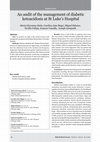
Malta Medical …, 2008
Aim: To perform an audit of the protocol used in the management of patients with Diabetic Ketoaci... more Aim: To perform an audit of the protocol used in the management of patients with Diabetic Ketoacidosis, in St Lukes Hospital. Methods: Patients admitted with 'Diabetes Ketoacidosis', between 14 th August 2004 and 14 th August 2005, were identified from the Admission book at the Accident and Emergency Department. Data obtained from patients' medical records were collected according to a preset proforma. The criteria assessed by this audit included parameter monitoring, investigations performed, the type and amount of intravenous fluids given, the insulin regime and potassium supplements used. Results: From a total of fifty six patients, forty seven files were traced, of which seventeen satisfied the criteria for Diabetic Ketoacidosis. Two were excluded and fifteen were analysed. In the population studied the mean age was 28 years with a male predominance of 60%. Ten patients suffered from Type 1 Diabetes whilst two patients had Type 2 Diabetes. Three other patients were newly diagnosed. Only one patient had all parameters checked according to protocol. In the majority of patients, fluids given in the first 22 hours, coincided with the amount of fluids stated in the protocol whilst 6/15 (40%) patients were administered the requested amount of insulin via infusion pump. With regards to potassium replacement, 13/15 (87%) patients were started on potassium supplements at a later stage. The factors influencing the total time for conversion to a fixed insulin regime and the duration of stay in hospital were also analysed. Conclusion: Deviations from the protocol were identified in parameter recording, the type of intravenous fluids given and the doses of insulin and potassium supplementation administered. New Diabetic Ketoacidosis guidelines have now been developed.

The Lancet. Oncology, Aug 1, 2017
Rare cancers pose challenges for diagnosis, treatments, and clinical decision making. Information... more Rare cancers pose challenges for diagnosis, treatments, and clinical decision making. Information about rare cancers is scant. The RARECARE project defined rare cancers as those with an annual incidence of less than six per 100 000 people in European Union (EU). We updated the estimates of the burden of rare cancers in Europe, their time trends in incidence and survival, and provide information about centralisation of treatments in seven European countries. We analysed data from 94 cancer registries for more than 2 million rare cancer diagnoses, to estimate European incidence and survival in 2000-07 and the corresponding time trends during 1995-2007. Incidence was calculated as the number of new cases divided by the corresponding total person-years in the population. 5-year relative survival was calculated by the Ederer-2 method. Seven registries (Belgium, Bulgaria, Finland, Ireland, the Netherlands, Slovenia, and the Navarra region in Spain) provided additional data for hospitals t...
keywords: heaLTh InformaTIon SySTem, SmaLL STaTeS, neTWorkInG, Who euroPean reGIon

Journal of the American Heart Association, 2016
Saturated fat (SFA), ω-6 (n-6) polyunsaturated fat (PUFA), and trans fat (TFA) influence risk of ... more Saturated fat (SFA), ω-6 (n-6) polyunsaturated fat (PUFA), and trans fat (TFA) influence risk of coronary heart disease (CHD), but attributable CHD mortalities by country, age, sex, and time are unclear. National intakes of SFA, n-6 PUFA, and TFA were estimated using a Bayesian hierarchical model based on country-specific dietary surveys; food availability data; and, for TFA, industry reports on fats/oils and packaged foods. Etiologic effects of dietary fats on CHD mortality were derived from meta-analyses of prospective cohorts and CHD mortality rates from the 2010 Global Burden of Diseases study. Absolute and proportional attributable CHD mortality were computed using a comparative risk assessment framework. In 2010, nonoptimal intakes of n-6 PUFA, SFA, and TFA were estimated to result in 711 800 (95% uncertainty interval [UI] 680 700-745 000), 250 900 (95% UI 236 900-265 800), and 537 200 (95% UI 517 600-557 000) CHD deaths per year worldwide, accounting for 10.3% (95% UI 9.9%-10.6%), 3.6%, (95% UI 3.5%-3.6%) and 7.7% (95% UI 7.6%-7.9%) of global CHD mortality. Tropical oil-consuming countries were estimated to have the highest proportional n-6 PUFA- and SFA-attributable CHD mortality, whereas Egypt, Pakistan, and Canada were estimated to have the highest proportional TFA-attributable CHD mortality. From 1990 to 2010 globally, the estimated proportional CHD mortality decreased by 9% for insufficient n-6 PUFA and by 21% for higher SFA, whereas it increased by 4% for higher TFA, with the latter driven by increases in low- and middle-income countries. Nonoptimal intakes of n-6 PUFA, TFA, and SFA each contribute to significant estimated CHD mortality, with important heterogeneity across countries that informs nation-specific clinical, public health, and policy priorities.
Antimicrobial Resistance and Infection Control, 2015
The results from our survey reveal that the general preparedness levels for management of potenti... more The results from our survey reveal that the general preparedness levels for management of potentially suspected cases of Ebola virus disease is only partially adequate in hospitals. Hospitals designated for admitting EVD suspected and proven patients had more frequently implemented Infection Control preparedness activities than hospitals that would subsequently transfer potential EVD cases to other centres. Results from this first international survey provide a framework for future efforts to improve hospital preparedness worldwide.
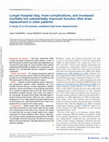
Acta orthopaedica, Jan 17, 2015
Background and purpose - Total knee replacement (TKR) is being increasingly performed in elderly ... more Background and purpose - Total knee replacement (TKR) is being increasingly performed in elderly patients, yet there is little information on specific requirements and complication rates encountered by this group. We assessed whether elderly patients undergoing TKR had different length of stay, requirements, complication rates, and functional outcomes compared to younger counterparts. Patients and methods - We analyzed prospectively gathered data on 3,144 consecutive primary TKRs (in 2,092 patients aged less than 75 years, 694 patients aged between 75 and 80 years, and 358 patients aged over 80 years at the time of surgery). Results - Incidence of blood transfusion, urinary catheterization, postoperative confusion, cardiac arrhythmia, and 1-year mortality increased with age, even after adjusting for confounding factors, whereas the incidences of chest infection and mortality at 1 month were highest in those aged 75-80. Rates of thromboembolism, prosthetic infection, and revision wer...

International Journal of Oral Science, 2015
The aim of this study was to investigate and compare the inheritance pattern and prevalence of in... more The aim of this study was to investigate and compare the inheritance pattern and prevalence of inheritable dental anomalies in a sample of patients with maxillary canine-first premolar transposition and their first-degree relatives with a sample of palatally displaced canine families. Thirty-five consecutive maxillary canine-first premolar transposition probands and 111 first-degree relatives were matched to 35 consecutive palatally displaced canine probands and 115 first-degree relatives. These were assessed for palatally displaced canines and incisor-premolar hypodontia. Parental age at birth of the proband was also noted. The results revealed that (i) there is no difference in the overall prevalence of palatally displaced canine or incisor-premolar hypodontia between the groups of relatives; (ii) first-degree relatives of bilateral palatally displaced canine probands have a higher prevalence of palatally displaced canine and incisor-premolar hypodontia than those with unilateral palatally displaced canine; and (iii) maternal age at birth of the maxillary canine-first premolar transposition probands was significantly higher than that of the palatally displaced canine probands. The results suggest that maxillary canine-first premolar transposition and palatally displaced canine are unlikely to be different genetic entities and also indicate environmental or epigenetic influences on dental development.International Journal of Oral Science (2015) 6, doi:10.1038/ijos.2014.72; published online 30 January 2015.

Paediatric and Perinatal Epidemiology, 2015
Neonatal mortality is a public health concern, and congenital anomalies contribute significantly ... more Neonatal mortality is a public health concern, and congenital anomalies contribute significantly to this mortality. This paper describes trends in neonatal mortality in Malta separately for congenital anomaly and non-congenital anomaly causes. Data for neonatal deaths of 22-week gestation onwards registered between 1994-2013 were obtained from the National Mortality Register. Chi-square tests were used to analyse 5-year time trends and differences in proportions of causes of neonatal deaths. Neonatal mortality was compared with other European countries. Between 1994 and 2013, 441 neonatal deaths and 84 821 livebirths were registered, giving a neonatal mortality of 5.2 per 1000 livebirths. Congenital anomalies accounted for 36.7% (n = 162) of the neonatal deaths, while the remaining 63.3% (n = 279) were attributed to non-congenital causes. During the 20-year period, neonatal mortality due to non-congenital causes decreased from 4.6 per 1000 livebirths in 1994-98 to 2.5 per 1000 in 2009-13, while that due to congenital anomalies remained stable (2.0 per 1000 livebirths in 1994-98 and 2.2 per 1000 in 2009-13). This has resulted in comparatively higher proportions of neonatal deaths attributed to congenital anomalies in recent years (45.9% in 2009-13 vs. 29.9% in 1994-98). Comparing neonatal mortality reported from European countries, Malta has a high rate most marked for deaths due to congenital anomalies. During 1994-2013, neonatal mortality has decreased due to a decline of non-congenital causes of death, possibly related to improved health care. The proportionate neonatal mortality attributed to congenital anomalies has increased and is the highest reported from Europe. This may be explained by the fact that termination of pregnancy is illegal in Malta.
International Cardiovascular Forum Journal, 2015
Primary Care Cardiovascular Journal (PCCJ), 2009
International Journal of Pediatric Otorhinolaryngology, 2011






Uploads
Papers by Neville Calleja